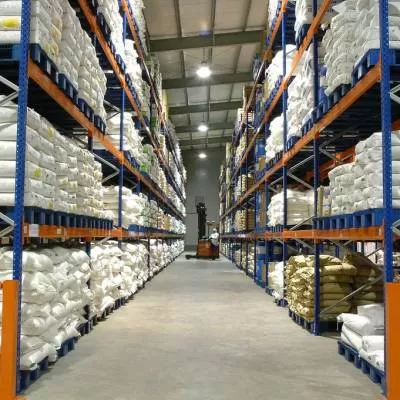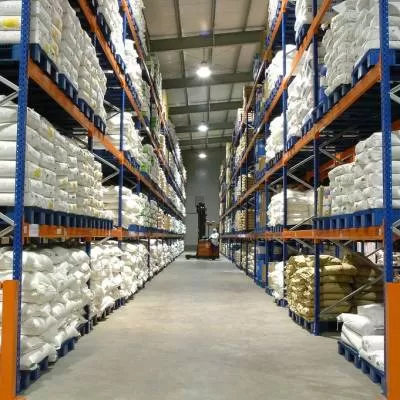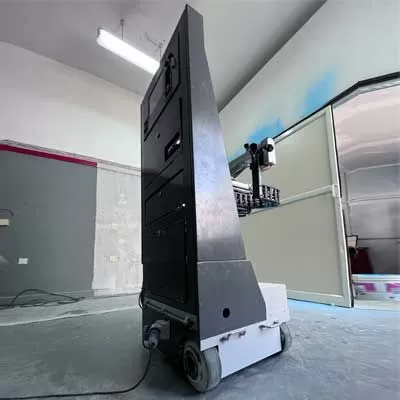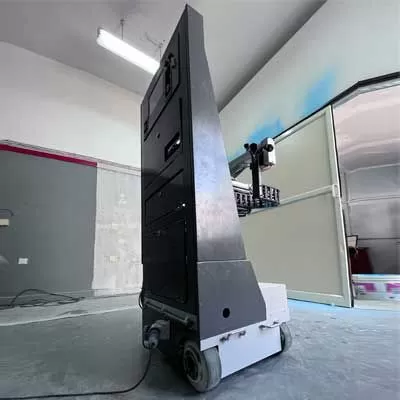- Home
- Infrastructure Urban
- WAREHOUSING & LOGISTICS
- The Store Age
The Store Age
According to the latest reports, India has a total warehousing space of about 1,800 million sq ft, of which around 8 per cent (144 million sq ft) is in the organised sector. On the other hand, cold storage solutions form about 85 per cent of the Indian cold chain market by value. This indicates a huge potential for quality warehousing space and cold storage systems. While rapid growth in international trade along with the rise in containerisation levels has created a high demand for warehouses in India; high growth prospects for the food processing sector along with attractive government incentives is driving the cold storage market.
“The need for warehousing is directly proportional to the consumption pattern in a particular market,” affirms Mayur Suchak, Managing Director, Renaissance Infra Realty. “Its requirement varies from industry to industry as different types of warehouses are built for agro and dairy products, FMCG, consumer durables and seasonal products, etc. Location-specific warehouses catering to the domestic market are also making inroads, the main advantage being their road connectivity throughout India.” For instance, Renaissance's warehousing park on the proposed ring road to Mumbai provides better connectivity than even air, rail or sea. The company has 18 RCC and PEB standard warehouse buildings of 132,000 sq ft. “We have demarcated 62.5 acre for customised warehouses,” Suchak adds. “The company specialises in built-to-suit (BTS) warehouses and is currently executing interior BTS in the existing standard design as per clients' specifications and needs. This customisation includes features like angular or perpendicular docking, height of around 13 m, dock shelters, factory-manual compliant flooring and insulation. These warehouses are mainly located in Bhiwandi, Mumbai, and are available in sizes ranging from 3 lakh sq ft onwards."
Road to development
“Many things like flooring, insulation, racking, palleting, loading and unloading bays need to be considered while developing a warehouse,” explains Suchak. “For general warehouses, the goods need to be protected from both internal and external environments, as some of them need lower temperatures than others. On the other hand, warehouses used specifically for storing construction-related products like cement, iron and steel do not need to consider these criteria and can be customised as per requirement.”
Warehouses should be designed to minimise material movement, optimise resources like docks and staging areas and meet business needs. In case of a large warehouse, meticulous planning of material storage is important. “Everything has to be well spaced out to enable the forklift to access the required package easily,” informs Aun Aejaz, Director, Doehle Danautic Logistics. “One shouldn’t have to continuously move 100 parcels to reach one parcel.” Fast movables and heavy goods should be located closer to docks, while slow moving stock and extra inventories should be placed on the top racks, away from the dock doors. As warehouses store material from different companies, there should be no cross movement of goods.
For adequate storage
A company that owns, works in or manages a warehouse should be aware of the importance of efficient storage systems. “The most common warehouse storage available today is the pallet racking system that utilises racks to store goods in multiple levels above the ground,” notes Suchak. “Rather than being limited to the storage of just one pallet, this racking system can stack up to four or five levels, thus enhancing space utilisation multifold.”
The mezzanine storage system also maximises the use of available warehouse space. It is a typical structure constructed between the main floors to store additional supplies or equipment. Often less expensive than other systems, it can be disassembled and moved to another location, if need be.
On the other hand, automated storage and retrieval systems are fairly recent introductions for warehouse storage. These utilise computers to store and recall materials by storage location. “They help maximise floor space as there is no height constraint for the fork lift operator,” adds Suchak.
With various advancements in warehousing technologies, manufacturers today have become more viable in their operations. “We can trace every package in our warehouse with the use of an RFID (radio frequency identification tag). Each time a package moves in the warehouse, its location is RFID’d into the SAP system of the customer, and he is updated with the physical status of his total stock and the individual package's exact location in the warehouse,” informs Aejaz.
Reliable transportation
As goods have to be delivered to customers over longer distances, efficient and reliable transportation is a prerequisite for warehouses. Renaissance has an exclusive road for each warehouse building with controlled access. “Our road system comprises an eight-lane, 121 ft central road, a four-lane, 68 ft main road along with wide internal loo roads. Almost 41.75 per cent of our land area is road, which helps smooth and easy goods movement and reduces turnaround time," Suchak elaborates. "Our traffic management systems are strategically planned to ensure that goods move business-class. The truck terminal has been designed considering the length of the containers (60, 40 and 30 ft) with a parking capacity of 100-120 trucks.”
Renaissance also provides a common facility centre that is strategically located and clustered for convenient access by logistic park members and external customers. Its facilities for in/outbound trucks include terminals, drivers’ dormitories with a capacity of 200 beds and vehicle-related services like washing bay, servicing, spare-parts shop, garage, petrol/CNG, etc. Other services include a first-aid centre and accident and emergency services.
Equipment needed
The advancement of equipment for warehouses is proportional to the cost of land and labour. "As labour cost keeps increasing, people will have to opt for more advanced equipment,” states CR Gole, Vice President, Action Construction Equipment. He further says that depending on the industry and products to be stored, various equipment including stackers, forklift trucks efficiently utilise vertical space. Generally, electric forklifts are preferred in warehouses, owing to their compact size and pollution-free features. People also opt for LPG forklifts as they are versatile and multipurpose. Additionally, more advanced equipment like articulated forklifts trucks that are smaller in size and can take loads at a height are also available in the market, though these are slightly more expensive.
Safety requirements
Safety is essential in any warehouse environment. Maintaining a safe warehouse promotes employee job satisfaction and decreases time off work owing to injury, thus helping to increase company profits. To promote a safe warehousing experience, Renaissance has created utility ducts for power, water, drainage and sewage alongside roads that reach each of its warehouse buildings. The company has also installed a fire hydrant with nine posts surrounding each of its warehouses. Other services include a first-aid centre, accident and emergency services. The warehouse designs of the company comply with fire norms, which enable customers to claim their insured goods in case of fire accidents. “We also have all the development and environmental plans and utility approvals,” reveals Suchak.
Future outlook
In developed countries, warehousing and distribution is a recognised industry. Unfortunately, in India, it has not been recognised as an industry or even a respectable business line. The Government of India is yet to put forth clear guidelines for setting up warehouses. This lacuna spells a tremendous opportunity for growth in this business in years to come.
The cold storage industry in India
As reported, the total value of India’s cold chain industry is currently estimated at US$ 3 billion and is growing at an annual rate of 20-25 per cent. By 2015, the industry’s total value is expected to reach US$ 8 billion through increased investments, modernisation of existing facilities and establishment of new ventures via private and government partnerships. India’s cold chain industry is still evolving, not well organised and operating below capacity. Most equipment in use is outdated and single-commodity based.
According to government estimates, India has 5,400 cold storage facilities, with a combined capacity of around 23.66 million metric tonne that can store less than 11 per cent of what is produced. The majority of cold storage facilities are utilised for a single commodity. Most of these facilities are located in Uttar Pradesh, Punjab, Uttaranchal, Maharashtra and West Bengal.
To share your views on this feature, write in at feedback@ASAPPmedia.com
Growing international trade in warehousing, coupled with high growth prospects in the cold chain business are a lucrative proposition in India, finds Shubhangi Bidwe.According to the latest reports, India has a total warehousing space of about 1,800 million sq ft, of which around 8 per cent (144 million sq ft) is in the organised sector. On the other hand, cold storage solutions form about 85 per cent of the Indian cold chain market by value. This indicates a huge potential for quality warehousing space and cold storage systems. While rapid growth in international trade along with the rise in containerisation levels has created a high demand for warehouses in India; high growth prospects for the food processing sector along with attractive government incentives is driving the cold storage market.“The need for warehousing is directly proportional to the consumption pattern in a particular market,” affirms Mayur Suchak, Managing Director, Renaissance Infra Realty. “Its requirement varies from industry to industry as different types of warehouses are built for agro and dairy products, FMCG, consumer durables and seasonal products, etc. Location-specific warehouses catering to the domestic market are also making inroads, the main advantage being their road connectivity throughout India.” For instance, Renaissance's warehousing park on the proposed ring road to Mumbai provides better connectivity than even air, rail or sea. The company has 18 RCC and PEB standard warehouse buildings of 132,000 sq ft. “We have demarcated 62.5 acre for customised warehouses,” Suchak adds. “The company specialises in built-to-suit (BTS) warehouses and is currently executing interior BTS in the existing standard design as per clients' specifications and needs. This customisation includes features like angular or perpendicular docking, height of around 13 m, dock shelters, factory-manual compliant flooring and insulation. These warehouses are mainly located in Bhiwandi, Mumbai, and are available in sizes ranging from 3 lakh sq ft onwards.Road to development“Many things like flooring, insulation, racking, palleting, loading and unloading bays need to be considered while developing a warehouse,” explains Suchak. “For general warehouses, the goods need to be protected from both internal and external environments, as some of them need lower temperatures than others. On the other hand, warehouses used specifically for storing construction-related products like cement, iron and steel do not need to consider these criteria and can be customised as per requirement.”Warehouses should be designed to minimise material movement, optimise resources like docks and staging areas and meet business needs. In case of a large warehouse, meticulous planning of material storage is important. “Everything has to be well spaced out to enable the forklift to access the required package easily,” informs Aun Aejaz, Director, Doehle Danautic Logistics. “One shouldn’t have to continuously move 100 parcels to reach one parcel.” Fast movables and heavy goods should be located closer to docks, while slow moving stock and extra inventories should be placed on the top racks, away from the dock doors. As warehouses store material from different companies, there should be no cross movement of goods.For adequate storageA company that owns, works in or manages a warehouse should be aware of the importance of efficient storage systems. “The most common warehouse storage available today is the pallet racking system that utilises racks to store goods in multiple levels above the ground,” notes Suchak. “Rather than being limited to the storage of just one pallet, this racking system can stack up to four or five levels, thus enhancing space utilisation multifold.”The mezzanine storage system also maximises the use of available warehouse space. It is a typical structure constructed between the main floors to store additional supplies or equipment. Often less expensive than other systems, it can be disassembled and moved to another location, if need be.On the other hand, automated storage and retrieval systems are fairly recent introductions for warehouse storage. These utilise computers to store and recall materials by storage location. “They help maximise floor space as there is no height constraint for the fork lift operator,” adds Suchak.With various advancements in warehousing technologies, manufacturers today have become more viable in their operations. “We can trace every package in our warehouse with the use of an RFID (radio frequency identification tag). Each time a package moves in the warehouse, its location is RFID’d into the SAP system of the customer, and he is updated with the physical status of his total stock and the individual package's exact location in the warehouse,” informs Aejaz.Reliable transportationAs goods have to be delivered to customers over longer distances, efficient and reliable transportation is a prerequisite for warehouses. Renaissance has an exclusive road for each warehouse building with controlled access. “Our road system comprises an eight-lane, 121 ft central road, a four-lane, 68 ft main road along with wide internal loo roads. Almost 41.75 per cent of our land area is road, which helps smooth and easy goods movement and reduces turnaround time, Suchak elaborates. Our traffic management systems are strategically planned to ensure that goods move business-class. The truck terminal has been designed considering the length of the containers (60, 40 and 30 ft) with a parking capacity of 100-120 trucks.”Renaissance also provides a common facility centre that is strategically located and clustered for convenient access by logistic park members and external customers. Its facilities for in/outbound trucks include terminals, drivers’ dormitories with a capacity of 200 beds and vehicle-related services like washing bay, servicing, spare-parts shop, garage, petrol/CNG, etc. Other services include a first-aid centre and accident and emergency services.Equipment neededThe advancement of equipment for warehouses is proportional to the cost of land and labour. As labour cost keeps increasing, people will have to opt for more advanced equipment,” states CR Gole, Vice President, Action Construction Equipment. He further says that depending on the industry and products to be stored, various equipment including stackers, forklift trucks efficiently utilise vertical space. Generally, electric forklifts are preferred in warehouses, owing to their compact size and pollution-free features. People also opt for LPG forklifts as they are versatile and multipurpose. Additionally, more advanced equipment like articulated forklifts trucks that are smaller in size and can take loads at a height are also available in the market, though these are slightly more expensive.Safety requirementsSafety is essential in any warehouse environment. Maintaining a safe warehouse promotes employee job satisfaction and decreases time off work owing to injury, thus helping to increase company profits. To promote a safe warehousing experience, Renaissance has created utility ducts for power, water, drainage and sewage alongside roads that reach each of its warehouse buildings. The company has also installed a fire hydrant with nine posts surrounding each of its warehouses. Other services include a first-aid centre, accident and emergency services. The warehouse designs of the company comply with fire norms, which enable customers to claim their insured goods in case of fire accidents. “We also have all the development and environmental plans and utility approvals,” reveals Suchak.Future outlookIn developed countries, warehousing and distribution is a recognised industry. Unfortunately, in India, it has not been recognised as an industry or even a respectable business line. The Government of India is yet to put forth clear guidelines for setting up warehouses. This lacuna spells a tremendous opportunity for growth in this business in years to come.The cold storage industry in IndiaAs reported, the total value of India’s cold chain industry is currently estimated at US$ 3 billion and is growing at an annual rate of 20-25 per cent. By 2015, the industry’s total value is expected to reach US$ 8 billion through increased investments, modernisation of existing facilities and establishment of new ventures via private and government partnerships. India’s cold chain industry is still evolving, not well organised and operating below capacity. Most equipment in use is outdated and single-commodity based.According to government estimates, India has 5,400 cold storage facilities, with a combined capacity of around 23.66 million metric tonne that can store less than 11 per cent of what is produced. The majority of cold storage facilities are utilised for a single commodity. Most of these facilities are located in Uttar Pradesh, Punjab, Uttaranchal, Maharashtra and West Bengal.To share your views on this feature, write in at feedback@ASAPPmedia.com





















